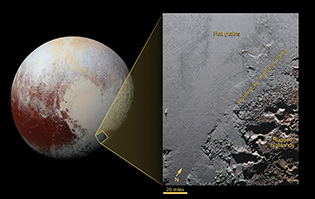Demystifying Space Medicine
The Health Risks of Spending Time in Outer Space
As NASA and private companies such as SpaceX and Blue Origin plot manned missions to Mars, human space flight beyond the moon may be inevitable in the next few decades. But space scientist and physicist Stamatios “Tom” Krimigis, a longtime champion of robotic technology to explore space, doesn’t think humans are ready to go to Mars—yet.
One of the major hurdles of long-term manned space flights is that scientists don’t yet know enough about how extended time in space affects the human body, Krimigis recently told an NIH audience at a “Demystifying Medicine” lecture on May 10.

JOHNS HOPKINS UNIVERSITY APPLIED PHYSICS LABORATORY/SOUTHWEST RESEARCH INSTITUTE
The “Demystifying Medicine” class that focused on the effects of spaceflight on health, featured space scientist Stamatios “Tom” Krimigis, who helped design NASA’s New Horizons spacecraft that orbited Pluto. This enhanced color view from New Horizons zooms in on the southeastern portion of Pluto’s great ice plains, where at lower right the plains border rugged, dark highlands informally named Krun Macula. More info at http://pluto.jhuapl.edu/Multimedia/Science-Photos/image.php?page=1&gallery_id=2&image_id=448
Krimigis is the only scientist in the world to have built instruments that have flown to every planet in the solar system. He has pioneered the exploration of our solar system and beyond for more than 45 years while serving in various positions at the Johns Hopkins University Applied Physics Laboratory in Laurel, Maryland, where he is the emeritus head of the Space Department. The Space Department has designed, built, and operated more than 64 spacecraft and 200 instruments, and it conducts space science and engineering research for both civilian and national security applications. Krimigis was the principal investigator on several NASA spacecraft, including Voyagers 1 and 2, and a co-investigator on many others. He is still active on missions to Mercury, Saturn, Pluto, and the heliosphere.
He is widely credited with resurrecting the idea of a space-probe exploration to Pluto. NASA had planned but then canceled a mission to the dwarf planet in 2000. Krimigis formed the New Horizons team, which engineered the interplanetary space probe. The New Horizons probe was launched in 2006, and in July 2015, it made headlines around the world when it completed the first flyby of Pluto.
NASA has also been developing the capabilities needed to send humans to Mars by the 2030s. To do so, researchers will need to learn more about human physiology in space and the necessary adaptation for long-term manned spaceflights.
During his talk at NIH, Krimigis said astronauts traveling in space for long periods of time likely have a higher risk for a wide range of medical problems, including balance disorders, visual alterations, cardiovascular deconditioning, bone loss, and cancer. Isolation and confinement in space may also lead to behavioral issues and sleep disorders. The distance from Earth also means astronauts can’t come home for medical treatments, driving the need for autonomous medical care.
Krimigis cited NASA data showing that, during space travel, astronauts’ percentage of muscle decreased during 161-day and 194-day missions on the International Space Station (ISS). “Some of the astronauts have a hard time walking when they get back,” he said.
Studies have also shown that bone-mineral density, a measurement of how much calcium and other types of minerals are in bone, dropped for astronauts who spent time in space. The most troubling aspect of long missions that last more than 90 days is the potential for radiation exposure, which may increase the risk for cancer, Krimigis said. He explained that astronauts aboard the Russian Space Station Mir, which operated from 1986 to 2001, were exposed to about 70 millisieverts (mSv) of radiation over 90 days while in orbit. The average person living in the United States is exposed to 3.1 mSv per year, according to the United States Nuclear Regulatory Commission (http://www.nrc.gov/reading-rm/doc-collections/fact-sheets/bio-effects-radiation.html). A 100-day mission to Mars could expose humans to 1,000 mSv of radiation, dramatically increasing cancer risk, Krimigis said.
NASA scientists are working on mathematical models to gauge radiation and other risks, but Krimigis said there is a huge need for more research.
“Animal models will be needed to assess clinical significance,” he said. That represents an area that NIH scientists could investigate.
Krimigis also said that biomarkers will be needed to assess individuals’ sensitivity and risk to radiation before astronauts are selected for manned missions. During these missions, pharmaceutical and nutritional countermeasures against radiation could be used to mitigate risk to radiation exposure. After returning to Earth, astronauts may need special occupational health care, personalized cancer screening, and even individualized cancer treatment.
Although a manned mission to Mars—or to any planet for that matter—is likely still many years away, Krimigis said it will be important for biomedical scientists to determine the effects that space travel will have on humans, address the medical concerns, and ensure the health and safety of astronauts and others who may venture into outer space.
To see a videocast of the May 10, 2016, Demystifying Medicine lecture “Robotic Planetary Exploration and Thoughts about Human Spaceflight” by Stamatios Krimigis, go to http://videocast.nih.gov/launch.asp?19675.
This page was last updated on Wednesday, April 13, 2022
